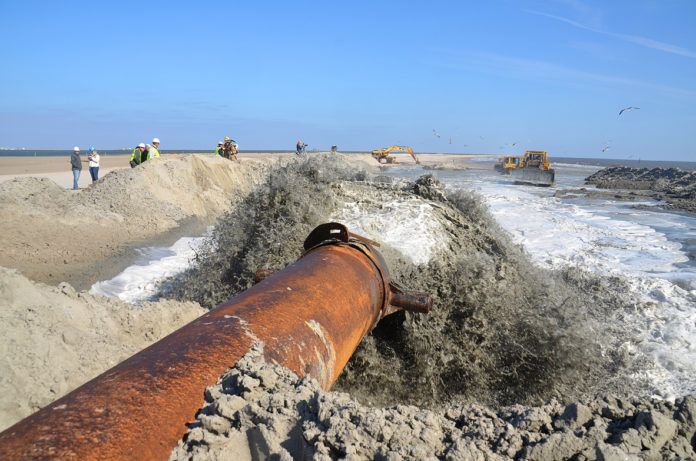Billions of dollars in new money for coastal projects in Louisiana is on the way. But work to enhance and protect the state’s fragile coastal regions has been going on for years.
Greg Grandy is a senior environmental manager for Coastal Engineering Consultants in Baton Rouge. His firm worked on the feasibility study for the state and the Army Corps of Engineers for the restoration of Caminada Headland, a 14-mile stretch of beach east of Port Fourchon. Over the past century, Caminada annually has lost an average of 35 feet of shoreline, according to the Louisiana Coastal Protection and Restoration Authority.
The work began in March 2005, and the study was supposed to be ready by September of that year, Grandy says. As you might expect, that year’s infamous hurricane season blew away the original timeline.
“A lot of the folks we were working with,” he says, “obviously, their priorities shifted.”
But now the project is back on track. More than 3 million cubic yards of sand is being dredged from a shoal at the bottom of the Gulf of Mexico and taken by tugboat-powered barges to the project site, where it is pumped out onto the beach. Native plants will be installed to help hold the sand in place.
Once restored, the beach should help buffer Port Fourchon and La. 1, a key hurricane evacuation route for Grand Isle and other communities, from storms, while providing habitat for nesting and migrating birds. This project is one tiny skirmish in Louisiana’s permanent war with the sea, and companies like Grandy’s are on the front lines.
“It’s an exciting time to be in the business, because there are opportunities today that weren’t available five, 10 or 15 years ago,” he says. “There are great problems to solve, and great challenges.”
UNPRECEDENTED FUNDING
Sediment deposited by the Mississippi River essentially created south Louisiana. But the levees that protect human life and property near the river also prevent the river from replenishing that sediment. To save the coast, humans must find ways to reverse that dynamic. Rising seas caused by a warming planet make the effort even more urgent.
The Coastal Wetlands Planning, Protection and Restoration Act of 1990, better known as the Breaux Act or by its acronym CWPPRA (often pronounced quip-pruh), was the first federal funding source for coastal restoration, providing tens of millions of dollars annually on an 85%/15% federal/state match. The feds also award grants through the Coastal Impact Assistance Program, though CIAP is currently scheduled to sunset at the end of 2016, says Chip Kline, who chairs the Coastal Protection and Restoration Authority board and is the governor’s top official for coastal restoration. (Kline replaced Garret Graves, who is now a congressman.)
But through the Gulf of Mexico Energy Security Act, or GOMESA, the state has begun receiving new money from offshore energy exploration. Assuming it survives the federal budgeting process, that revenue stream will increase in 2017.
Now, as BP and Transocean begin to pay for natural resource damage, along with criminal and civil penalties, associated with the 2010 Gulf oil spill, an unprecedented infusion of new dollars are on the way.
Put all that money together and you’ve got something in the neighborhood of $1 billion a year, Kline says during an interview in his fourth floor State Capitol office. The state’s coastal master plan envisions $50 billion worth of projects over 50 years, and Louisiana is projected to spend $500 million to $2 billion per year for the next 50 years on water-related research and projects in marsh creation, protection systems, sediment diversion and restoration.
“I think you’re going to see a lot of the same type of work that we’ve done, but on a much larger scale,” Kline says.
That means moving away from smaller-scale restoration projects to projects in the $300 million to $400 million range with “more of a substantial impact” on saltwater intrusion and coastal land loss.
In the past, $60 million to $70 million marsh creation projects were typical, he says. In the future, we could see construction of a single long distance sediment pipeline that would cost more than 10 times that amount. This fall, officials will start to make decisions about major sediment diversions, which can be controversial because of the perceived impact on prime areas for harvesting fish, shrimp and oysters.
“We’re on pace [in fulfilling the master plan], and I think over the next 15 years we are absolutely going to be on pace, and perhaps even ahead of schedule,” Kline says.
ALREADY UNDERWAY
On Aug. 19, CPRA Executive Director Kyle Graham gave the authority’s board an update on oil spill restoration planning. He mentioned six projects worth a total of about $223 million that already are approved and underway with oil spill money, including work at Caminada. But most of the specific projects listed during his presentation remain in the “probable” category.
“I know this will change,” Graham says. “But I do think it’s also important that we start to lay the foundation so that folks are aware of where we are in our planning mode and how we see all of the various revenue streams starting to tie together as we ultimately build projects across the coast.” He noted that most of the oil spill money will be coming down over 15 years, and there will be three or four master plan updates during that time.
As he explained, there will be three separate funding streams related to the spill. Louisiana’s share of the criminal penalties will be about $1.27 billion. The National Fish and Wildlife Foundation will administer those funds, which only can be used for barrier island and river diversion projects, and proposals will require approval by that federation’s board and the CPRA’s.
The state also is set to receive more than $5 billion to ameliorate natural resource damage. An initial payment of $368 million has been received, with 15 installments expected over the next 16 years. A draft plan meant to assess the damage and nail down exactly how much Louisiana will get is supposed to be ready in October, in advance of finalizing the consent decree in early 2016.
Funds from the RESTORE Act, which dedicates 80% of Clean Water Act penalties to the affected Gulf states, are divvied up by a complicated formula for various types of projects. Louisiana’s share is expected to be at least $930 million.
Some of the new money will go toward helping types of wildlife harmed by the spill, rather than for projects in the state’s coastal restoration master plan. The inverse also is true: Some projects funded by spill-related dollars won’t directly address damage from the spill, but will pay for master plan projects that complement efforts to repair the oil-damaged coast. The coast is an interrelated ecosystem, and project planning will reflect that.
Since the oil spill money is coming in over 15 years, Graham suggests that the state may want to look into getting creative with its new funds to get more projects under construction quickly. Perhaps offshore oil revenue could be used as a kind of loan that would be paid back with RESTORE dollars. Maybe one of the funding streams can be securitized to get more money up front.
All projects will be publicly bid, which means the state takes the lowest bidder who is qualified to handle the job.
JOB SECTOR
The water management sector potentially could create 10,000 to 20,000 new direct jobs, plus 10,000 to 25,000 new indirect jobs, through 2030, according to a set of analyses performed by McKinsey & Company for Louisiana Economic Development and the Louisiana Recovery Authority Support Foundation in 2010.
“We foresee Louisiana as not only addressing its own water management issues but also developing scientific, engineering and construction expertise in the field that can be exported worldwide,” says LED Secretary Steven Grissom.
Despite the expected increase in coastal work, state officials are not expecting a workforce crunch. There will be significant crossover of workers from shipbuilding, maritime and other oil-and-gas-related jobs, explains Aaron Caffarel with the Louisiana Workforce Commission. So the slowdown in the oil patch adds to the potential labor pool.
The Louisiana Community & Technical College System runs training programs for the relevant jobs in the Houma/Thibodaux region. Caffarel says a workforce commission program, whereby contractors on coastal restoration projects submit lists of job openings and the LWC helps recruit and refer eligible candidates, hasn’t been used very much yet, though that could change as the amount of work increases.
While the BP spill money will be a tremendous boost to the state’s efforts over the next 15 years, it’s important to remember that the current master plan is a 50-year blueprint. Eventually, Kline says, a permanent, sustainable funding stream must be found, because the need will never go away.
As CPRA spokesman Chuck Perrodin explains, the master plan shows that Louisiana can halt land loss in about 30 years and start to gain net land, but it’s like owning a house: maintenance, roof replacement, painting, repairs, fighting termites; those things never end. And neither will our fight against the sea.









